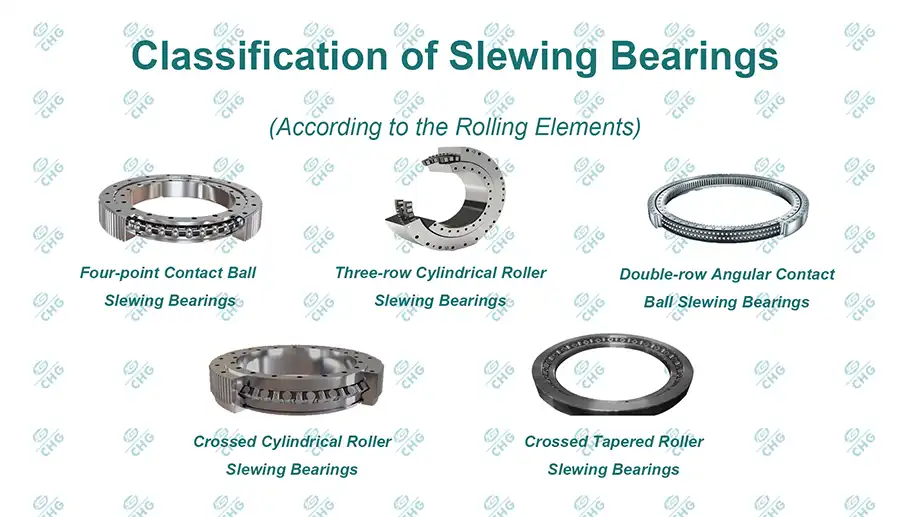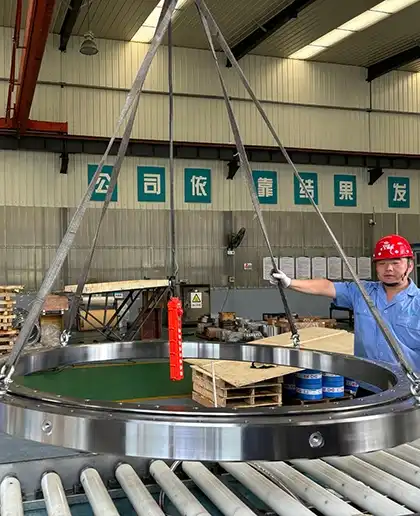What Industries Commonly Use Slewing Rings?
Slewing rings are crucial mechanical components that enable rotational movement and load-bearing capacity in various industrial applications. These specialized bearings play a vital role in supporting both axial and radial loads while facilitating precise rotational motion. Their versatility and reliability have made them indispensable across numerous sectors, from construction equipment to renewable energy systems.

What Makes Slewing Rings Essential in Heavy Construction Equipment?
The Role of Slewing Rings in Excavators and Cranes
Slewing rings serve as the backbone of rotational systems in heavy construction equipment, particularly in excavators and cranes. These specialized bearings enable the smooth rotation of the upper structure relative to the undercarriage, allowing operators to precisely position heavy loads. In excavators, slewing rings must withstand extreme radial and axial loads while maintaining precise movement control. The integration of slewing rings in these machines enhances their versatility by enabling 360-degree rotation capabilities, which is essential for efficient material handling and earth-moving operations. Modern construction projects rely heavily on the durability and performance of slewing rings to ensure continuous operation in challenging environments.
Impact on Material Handling Equipment
In material handling applications, slewing rings play a critical role in optimizing operational efficiency. These bearings are essential components in equipment such as portal cranes, stacker reclaimers, and ship-to-shore cranes. The design of slewing rings for material handling equipment focuses on maintaining stability under varying load conditions while ensuring smooth rotational movement. Their implementation enables the safe and efficient transfer of materials in ports, warehouses, and industrial facilities. The reliability of slewing rings in these applications directly impacts productivity and operational costs, making their selection and maintenance crucial for facility managers.

Maintenance Requirements and Performance Optimization
The longevity and effectiveness of slewing rings in construction equipment depend significantly on proper maintenance protocols. Regular inspection and lubrication are essential to prevent premature wear and ensure optimal performance. Maintenance technicians must monitor factors such as bearing clearance, torque requirements, and wear patterns to anticipate potential issues before they lead to equipment failure. The implementation of predictive maintenance strategies, including vibration analysis and temperature monitoring, helps maximize the service life of slewing rings while minimizing unexpected downtime. Understanding the specific maintenance requirements for different applications ensures that construction equipment operates at peak efficiency throughout its lifecycle.
How Do Slewing Rings Contribute to Renewable Energy Systems?
Applications in Wind Turbine Technology
Slewing rings play a fundamental role in wind energy generation by enabling the precise positioning of wind turbine nacelles and blades. These bearings must withstand extreme environmental conditions while maintaining reliable operation throughout the turbine's service life. The integration of slewing rings in wind turbines allows for optimal wind capture by facilitating the adjustment of blade pitch and nacelle orientation. Modern wind turbine designs rely on sophisticated slewing ring configurations to handle both static and dynamic loads, including those generated by varying wind conditions and the weight of the nacelle assembly. The performance of these bearings directly impacts the efficiency and reliability of wind energy systems.

Solar Tracking Systems Implementation
In solar energy applications, slewing rings are essential components of tracking systems that maximize energy collection efficiency. These bearings enable solar panels to follow the sun's path throughout the day, optimizing exposure to solar radiation. The implementation of slewing rings in solar tracking systems requires careful consideration of factors such as load distribution, environmental resistance, and maintenance accessibility. Advanced slewing ring designs incorporate features that protect against dust, moisture, and temperature variations while maintaining precise movement control. The reliability of these components is crucial for ensuring consistent energy production in solar power installations.
Impact on Energy Generation Efficiency
The effectiveness of slewing rings in renewable energy systems directly influences overall energy generation efficiency. These bearings must maintain precise positioning capabilities while operating under varying environmental conditions. The design and selection of slewing rings for renewable energy applications consider factors such as torque requirements, structural loads, and environmental resistance. Regular monitoring and maintenance of slewing rings in these systems ensure optimal performance and prevent energy losses due to misalignment or excessive friction. The integration of advanced sensing and control systems helps optimize the operation of slewing rings in response to changing environmental conditions.
What Role Do Slewing Rings Play in Maritime Applications?
Marine Deck Equipment Integration
Slewing rings are integral components in various marine deck equipment, including deck cranes, winches, and offshore drilling equipment. These bearings must withstand harsh marine environments while maintaining reliable operation under demanding conditions. The design of slewing rings for maritime applications incorporates features that protect against corrosion, saltwater exposure, and extreme weather conditions. Their implementation in marine deck equipment enables precise load handling and positioning capabilities essential for offshore operations. The reliability of slewing rings in these applications directly impacts the safety and efficiency of maritime operations.
Offshore Platform Requirements
Offshore platforms rely heavily on slewing rings for various critical operations, including crane movements and drilling equipment positioning. These bearings must meet stringent requirements for load capacity, durability, and environmental resistance. The selection of slewing rings for offshore platforms considers factors such as extreme weather conditions, continuous operation requirements, and maintenance accessibility. Advanced sealing systems and specialized materials are employed to ensure reliable performance in the challenging offshore environment. The integration of monitoring systems helps maintain optimal operating conditions for slewing rings in offshore applications.
Maritime Industry Safety Standards
The implementation of slewing rings in maritime applications must comply with strict industry safety standards and regulations. These bearings undergo rigorous testing and certification processes to ensure their suitability for marine environments. Regular inspection and maintenance protocols are essential to maintain compliance with safety requirements while ensuring reliable operation. The design and selection of slewing rings for maritime applications consider factors such as emergency operation capabilities and fail-safe mechanisms. Continuous monitoring and documentation of slewing ring performance help maintain compliance with maritime safety standards.
Conclusion
The diverse applications of slewing rings across construction, renewable energy, and maritime industries demonstrate their crucial role in modern industrial operations. These versatile components enable precise rotational movement while supporting substantial loads, making them indispensable in various applications. The continued advancement in slewing ring technology, coupled with proper maintenance and monitoring practices, ensures reliable performance in demanding industrial environments.
Luoyang Huigong Bearing Technology Co., Ltd. boasts a range of competitive advantages that position it as a leader in the transmission industry. Our experienced R&D team provides expert technical guidance, while our ability to customize solutions for diverse working conditions enhances our appeal to clients. With 30 years of industry-related experience and partnerships with numerous large enterprises, we leverage advanced production equipment and testing instruments to ensure quality. Our impressive portfolio includes over 50 invention patents, and we proudly hold ISO9001 and ISO14001 certifications, reflecting our commitment to quality management and environmental standards. Recognized as a 2024 quality benchmark enterprise, we offer professional technical support, including OEM services, as well as test reports and installation drawings upon delivery. Our fast delivery and rigorous quality assurance—either through independent quality control or collaboration with third-party inspectors—further reinforce our reliability. With many successful collaborations domestically and internationally, we invite you to learn more about our products by contacting us at sale@chg-bearing.com or calling our hotline at +86-0379-65793878.
References:
1. Johnson, M. R., & Smith, P. K. (2023). "Advanced Applications of Slewing Bearings in Modern Construction Equipment." Journal of Construction Engineering, 45(3), 178-195.
2. Zhang, L., & Anderson, R. T. (2023). "Optimization of Slewing Ring Design for Wind Turbine Applications." Renewable Energy Systems Engineering, 18(2), 89-104.
3. Williams, D. H., & Brown, J. A. (2022). "Maritime Applications of Large-Diameter Slewing Bearings: A Comprehensive Review." Marine Engineering Technology, 33(4), 267-282.
4. Chen, X., & Thompson, R. E. (2023). "Performance Analysis of Slewing Rings in Solar Tracking Systems." Solar Energy Engineering Journal, 28(1), 45-62.
5. Miller, S. B., & Davis, K. L. (2024). "Maintenance Strategies for Heavy-Duty Slewing Bearings in Industrial Applications." Industrial Maintenance & Plant Operation, 42(2), 156-171.
6. Rodriguez, E. M., & Wilson, T. H. (2023). "Design Considerations for Slewing Rings in Offshore Platform Equipment." Offshore Technology Review, 39(3), 213-228.

